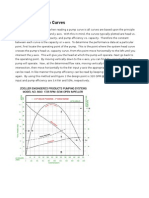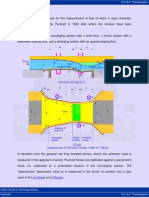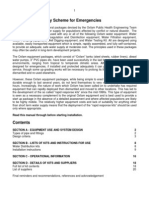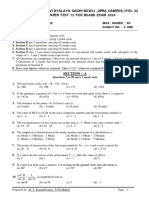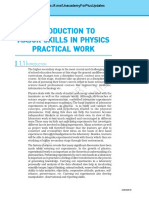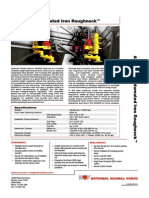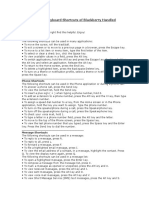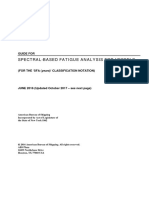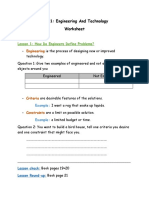SUBMERSIBLE PUMP Selection
SUBMERSIBLE PUMP Selection
Uploaded by
Syed Muztuza AliCopyright:
Available Formats
SUBMERSIBLE PUMP Selection
SUBMERSIBLE PUMP Selection
Uploaded by
Syed Muztuza AliOriginal Description:
Copyright
Available Formats
Share this document
Did you find this document useful?
Is this content inappropriate?
Copyright:
Available Formats
SUBMERSIBLE PUMP Selection
SUBMERSIBLE PUMP Selection
Uploaded by
Syed Muztuza AliCopyright:
Available Formats
SUBMERSIBLE PUMP selection
A submersible pump consists of the following basic elements: < Bowl Assembly < Motor < Cable < Drop Pipe < Surface Plate (with)(without) discharge elbow
DATA REQUIRED FOR SELECTION < Capacity in GPM < Static and Pumping Levels in Well < Setting Required (drop pipe) < Well I.D. Diameter < Electric Characteristics
DETERMINATION OF TOTAL HEAD Total head = H + P + F where: H = Distance from surface to water level when pumping P = Pressure (head) at pump discharge F = Drop pipe friction (+) check valve(s) loss
BOWL ASSEMBLY SELECTION Select impeller in exactly the same manner as for lineshaft type pump. Note comments under WELL SIZE. DROP PIPE SELECTION Size of drop pipe is selected based on the capacity to be pumped. Submersible pumps frequently require smaller drop pipe than do line shaft pumps since the full area of the pipe is used to deliver water to the surface. Minimum velocity in drop pipe should not be less than 3.5Ft./Sec. We recommend drop pipe size be selected to limit the maximum friction loss to 5 per 100 of pipe. Selection table is based upon this limitation. Smaller size drop pipe may be used when bowl assembly and motor are adequate for operation with the increased head and horsepower. Pipe furnished by others must be standard pipe with 3/4 taper NPT threading throughout and to connect to the bowl assembly and surface plate. CHECK VALVES Where total head exceeds 200, the use of a drop pipe check valve is recommended. Check valve should be located approximately 20 above the bowl assembly. For settings over 600, the use of two check valves are recommended, with the first valve approximately 100 above bowl unit and the second located approximately 60% of the distance between the first valve and the surface plate.
SUBMERSIBLES
233
SUBMERSIBLE PUMP selection (cont.)
CABLE SELECTION Select a drop cable designed for use in water. The insulation on the conductors should be RW, RUW, TW, or their equivalent. DO NOT compromise on drop cable quality. Paying a little more will save you money in the long run. Cable selection chart is based on horsepower, voltage, and length of cable required. Cable sizes and lengths are maximum allowable. Higher operating efficiency will be obtained by using the next larger cable size when lengths approach listed limits. All size and cable lengths shown are for copper wire only. NOTE: Use of smaller cable than recommended will void warranty. Select cable length equal to length of setting plus an additional 10 or more to connect to starter at the surface, plus 1 additional foot for each 50 of length in the well to compensate for unavoidable slack in the installation. SURFACE PLATE Surface place consists of flat steel plate with connection for drop pipe, hole for entrance of cable, vent hole, hole for air line or water level gauge. Surface plate is supplied (with)(without) elbow. If elbow is furnished, it can be flanged or female thread. Surface plate is selected to match drop pipe size. MOTOR SELECTION Motor selection is based upon horsepower required, pump RPM, thrust load, well diameter, and power supply. Also, see comments under WELL SIZE and WATER TEMPERATURE. STARTING EQUIPMENT Selecting the proper overload protection is one of the most important factors in obtaining a successful submersible installation. Submersible motor starters should provide the following: < Positive motor protection against single phasing. < Positive motor protection against sustained overload in excess of 115% of motor rating. < Motor protection if rotor is stalled. < Tripping timers independent of ambient temperature; (Ambient Compensated Quick Trip Heaters).
NOTE: Failure to provide quick trip overload heaters will void warranty. Also, note that under certain conditions of maximum load on the motor (use of the 1.15 service factor), a starter one size larger may be required. LIGHTNING PROTECTION Lightning and power surge damage are major causes of submersible motor failures, so a three-phase lightning arrestor is a must. The arrestor is mounted in the pump panel and grounded to both ground terminals onto pump panel and well head. If you use plastic pipe, the ground wire should also be connected to a stud on the motor to obtain good grounding and maximum benefit from the arrestor. WARNING: Failure to ground this unit may result in serious electrical shock. A faulty motor or wiring can be a serious electrical shock hazard if it is accessible to human contact. To avoid this danger, connect the motor frame to the power supply grounding terminal with copper conductor no smaller than the circuit conductors. In all installations, connect above ground metal plumbing to the power supply ground per National Article 250-80 to prevent shock hazard.
SUBMERSIBLES
234
Selection procedure example
Requirements: Capacity..............................................850 GPM Head...................................................140 Feet Pumping Level....................................200 Feet Well Diameter.....................................12 Inside Diameter Power Supply......................................3 Ph. / 60 Hertz / 480 Volts Pumping Liquid...................................Fresh Water
1. Determine Total Dynamic Head: (TDH) = pumping level + head required + drop pipe friction loss + check valve(s) friction TDH = a. Pumping level.................................................................... ..............200 Feet b. Head required..................................................................................140 Feet c . 8 drop pipe friction head for 850 GPM is 2.2 feet per 100 feet. 200 feet of new 8 drop pipe has a total loss of 2.2 x 2.0 =..........4.4 Feet d. Friction head loss in one 8 check valve =......................................2.2 Feet TOTAL Dynamic Head (TDH)......................................................... 346.6 Feet
2. Impeller Selection: Since no speed was specified, use 3450 RPM. The S9XHC shows 76% efficiency, full diameter.
a. Number of stages required = No. Stg. = TDH = 346.6 = 2.78 USE 3 stages, 75.5% Head/Stage 125
b. Total Pump Thrust = TDH x Impeller Thrust Factor x Sp. Gr. + (Rotor weight per stage x number of stages) (349.55 x 4.9 x 1) + (10.6 x 3) = 1744.6
c. Bowl Horsepower = GPM x TDH x Sp. Gr. = 850 x 346.6 x 1 = 98.54 BHP 3960 x Bowl Eff. 3960 x 75.5% d. Pump Efficiency = GPM x TDH x Sp. Gr. = 850 x 346.6 x 1 = 75.5% 3960 x Bowl H.P. 3960 x 98.54
SUBMERSIBLES
235
Selection procedure example (cont.)
3. Motor Selection: a. Bowl Horsepower = 98.54 b. Pump Operating Speed = 3450 RPM c. Total Pump Thrust = 1744.6 d. 3 Phase, 60 Hertz, 460 Volts (nameplate) e. Thrust Bearing Loss = .10 x Total Pump Thrust = .10 x 1744.6 = .17 H.P. 1000 1000 f. Horsepower Loss in Cable: Total Cable Length = 200 feet + 10 + 4 = 214 feet Select #00 cable from Selection Chart 100 H.P. motor current = 130 amps full load Horsepower loss in #00 cable = H.P. loss per 100 x Total Cable Length = .65 x 214 = 1.39HP 100 100 g. Total Horsepower: = Bowl horsepower + Thrust HP loss + Cable horsepower loss = 98.54 + 1.39 + .17 = 100.10 H.P. (100 H.P. motor OK to use.) 4. Cable Selection: a. Determine total cable length. Total Cable Length = Pumping Level + Surface Length + Slack = 200 + 10 + 4 = 214 feet b. Per Cable Selection Chart @ 460 volts horsepower, use #00 cable. 5. Surface Plate: Use 8 surface plate. 6. Check Valve: One 8 check valve required. 7. Calculation of Field Performance: To determine field head and overall pump efficiency: a. Field Head = laboratory head minus total friction loss. (1) Total friction loss = loss in drop pipe + check valve(s) b. Overall Pump Efficiency = Water HP x (motor eff. % - cable loss %) Laboratory H.P. c. Water Horsepower = GPM x Head 3960 d. Laboratory Horsepower = GPM x Head x Sp. Gr. 3960 x Pump Eff. Calculations for other values of power consumption can be carried out per equations noted below: e. Wire to Water Efficiency - same as Overall Efficiency. f. Input Horsepower = Pump Brake Horsepower Motor Efficiency - Cable Loss g. Wire to Water Horsepower = Same as Input Horsepower h. Kilowatt Hours per 100 Gallons = Field head x .00314 Overall Efficiency i. Kilowatts Input = Input Horsepower x 0.746 j. Gallons per Kilowatt Hour = Overall Efficiency x 1000 Field Head x .00314
SUBMERSIBLES
236
DETERMINATION OF FIELD PERFORMANCE
general instructions 1. Select drop pipe size from selection chart. (NOTE: 5 per 100 friction loss is maximum; 3.5/Sec. velocity is minimum.) a. Calculate drop pipe friction loss Friction per 100 feet x drop pipe length + check valve friction loss 100 b. Calculate Total Dynamic Head (TDH) TDH = Pumping level + discharge head required at surface + check valve friction loss + drop pipe friction loss
2. Impeller Selection: From performance curves with known capacity and speed, select the bowl assembly that has its peak efficiency as close as possible to desired capacity. Well I.D. must be larger than bowl diameter. If speed is unknown, the speed should be as high as possible for a given capacity. a. Number of stages required = TDH = Number of stages Head/stage b. Total Pump Thrust = (TDH x Impeller Thrust Factor x Sp. Gr.) + (rotor weight per stage x number of stages) c. Bowl Horsepower = GPM x TDH x Sp. Gr. 3960 x Bowl Eff. d. Pump Efficiency = GPM x TDH x Sp. Gr. 3960 x Bowl H.P.
SUBMERSIBLES
237
DETERMINATION OF FIELD PERFORMANCE (cont.)
3. Motor Selection: Select the proper electric motor from the following: a. Bowl Horsepower b. Pump Operating Speed c. Total Pump Thrust d. Electric Power Supply Available e. Thrust Bearing Loss in H.P. Horsepower loss per 1000# thrust (given by manufacturer is approx. .09 per 1000# thrust; use .10 H.P. per 1000#) = .10 x total pump thrust # 1000# f. Horsepower loss in cable (from Cable Loss Chart) to determine horsepower loss per 100 feet. Total horsepower loss in cable = horsepower loss per 100 x Total Cable Length 100 NOTE: Total cable length = pumping level + distance from well at surface to starter panel + allowance for slack. g. Total Horsepower: Total H.P. = bowl horsepower + thrust horsepower loss + cable horsepower loss
4. Cable Selection: a. Determine total cable length. Total cable length = pumping level + surface distance to starter panel + allowance for slack NOTE: (1) (2) Slack cable, allow 2 feet per 100 feet 10 foot minimum for surface cable to starter
b. From cable selection chart under proper voltage, select cable under motor full load amps for length of cable used. NOTE: If full load amps fall between amps on chart, go to next larger size.
5. Surface Plate: Select the same size as drop pipe diameter. 6. Check Valve: Select the same size as drop pipe diameter (if required by Technical Data). 7. Accessories: a. b. c. d. e. Pump Panel Air Line and Gauge Banding Tools Banding Supplies Cable
SUBMERSIBLES
238
You might also like
- ISO 17781 2017 EditionDocument26 pagesISO 17781 2017 EditionNirmal100% (7)
- Subiecte Olimpiada Limba Engleza Clasa A 7-ADocument3 pagesSubiecte Olimpiada Limba Engleza Clasa A 7-ALivia Hagiu86% (7)
- Pump Power Calculation - 2Document5 pagesPump Power Calculation - 2Alexander MugabeNo ratings yet
- Lecture 6-Best Hydraulic SectionsDocument5 pagesLecture 6-Best Hydraulic SectionsDanny Cheng100% (2)
- Chapter - 09 ESP Design ExamplesDocument16 pagesChapter - 09 ESP Design Examplesdewidar1234100% (11)
- XCOM User Guide PDFDocument39 pagesXCOM User Guide PDFaleman100% (1)
- 12 Pump Sizing Example 1 & 2ADocument37 pages12 Pump Sizing Example 1 & 2AMohamed Abd El-Moniem100% (1)
- WS Fixture Flow Rates PDFDocument1 pageWS Fixture Flow Rates PDFbilal almelegyNo ratings yet
- Open Channel Flow Guide - Solartron MobreyDocument35 pagesOpen Channel Flow Guide - Solartron MobreyBrian McMorris100% (2)
- 2-Water Distribution SystemDocument38 pages2-Water Distribution SystemCak IzaTyNo ratings yet
- Sand Filter Next GenDocument18 pagesSand Filter Next GenJairEstevao100% (1)
- Chapter 3 - PumpsDocument66 pagesChapter 3 - Pumpsmohd irfanNo ratings yet
- Two Story Apartment Water Distribution SystemDocument36 pagesTwo Story Apartment Water Distribution SystemzaccNo ratings yet
- Centrifugal PumpsDocument27 pagesCentrifugal PumpsNischal LgNo ratings yet
- Reading Pump CurvesDocument4 pagesReading Pump CurvesRobert Barrett100% (1)
- SAB2513 Hydraulic Chapter 7Document37 pagesSAB2513 Hydraulic Chapter 7Tuan JalaiNo ratings yet
- Pumping Stations Design Lecture 5Document60 pagesPumping Stations Design Lecture 5Misama Nedian100% (1)
- Appendix Sizing The Building Water Supply and Distribution Piping SystemsDocument36 pagesAppendix Sizing The Building Water Supply and Distribution Piping SystemsMahmood BadawiNo ratings yet
- Performance of Dual Media Downflow Rapid Gravity FiltersDocument7 pagesPerformance of Dual Media Downflow Rapid Gravity FiltersBasproNo ratings yet
- Automatic Water Flow ControlDocument18 pagesAutomatic Water Flow Controlssgjmlim100% (2)
- Pump NPSH (Net Positive Suction Head)Document8 pagesPump NPSH (Net Positive Suction Head)farhan_katpar1838No ratings yet
- Appendix P - Sizing of Water Piping SystemDocument20 pagesAppendix P - Sizing of Water Piping SystemDeese MarieNo ratings yet
- Passavant E&E Company Profile-4th QTRDocument77 pagesPassavant E&E Company Profile-4th QTRSami Sawalha100% (1)
- Water Purification Plant 1000 GPH Capacity SSDocument9 pagesWater Purification Plant 1000 GPH Capacity SSHaiDer J MarWatNo ratings yet
- Water Distribution SystemDocument21 pagesWater Distribution Systemsunny_2502No ratings yet
- Hydraulic AnalysisDocument59 pagesHydraulic AnalysisFebe CabalatunganNo ratings yet
- How To Calculate Water Pump Horsepower - 14 Steps (With Pictures)Document3 pagesHow To Calculate Water Pump Horsepower - 14 Steps (With Pictures)ren salazarNo ratings yet
- Design and Analysis of Centrifugal PumpsDocument2 pagesDesign and Analysis of Centrifugal PumpsMTOLNo ratings yet
- Parshall FlumesDocument6 pagesParshall FlumesSubhadip NandiNo ratings yet
- High Pressure High Temperature Filter Press ReportDocument16 pagesHigh Pressure High Temperature Filter Press ReportMJ LagradaNo ratings yet
- Continuous Sand Filter - 11110Document2 pagesContinuous Sand Filter - 11110ganeshNo ratings yet
- Pump Sizing and CalculationsDocument5 pagesPump Sizing and CalculationsHamid Mansouri50% (2)
- Concrete Volute PumpsDocument8 pagesConcrete Volute PumpsvijayunityNo ratings yet
- Design of PumpsDocument29 pagesDesign of PumpsRenz Alfred Adremesin100% (1)
- Sewer Lift StationDocument15 pagesSewer Lift StationFrancisco M. RamosNo ratings yet
- Electrical Submersible PumpDocument24 pagesElectrical Submersible PumpJorge Mártires100% (3)
- Water Demand Assessment For Urban ProjectsDocument44 pagesWater Demand Assessment For Urban ProjectsShashikant Dattatray ChawatheNo ratings yet
- Rapid Sand FilterDocument30 pagesRapid Sand Filtersachinambekar100% (1)
- Hydrualic Pipe Network Design ProjectDocument15 pagesHydrualic Pipe Network Design ProjectMotasem Miqdad100% (1)
- ESP Pump Selection, Evaluation Improve Well Inflow, Volumes - Oil & Gas JournalDocument7 pagesESP Pump Selection, Evaluation Improve Well Inflow, Volumes - Oil & Gas JournaljoreliNo ratings yet
- Electrical Submersible Pumps DesigningDocument17 pagesElectrical Submersible Pumps Designingdhulfikarfadhil100% (1)
- Pump Head CalculationDocument2 pagesPump Head Calculationkenoly123No ratings yet
- 19.2. Dewatering of Sludge by FiltrationDocument46 pages19.2. Dewatering of Sludge by FiltrationClaudia AvramNo ratings yet
- Centrifugal PumpsDocument27 pagesCentrifugal PumpsHossam SalahNo ratings yet
- Pump CalculationDocument7 pagesPump CalculationPiping_Specialist100% (1)
- 1,2,3 - Water Supply and DistributionDocument5 pages1,2,3 - Water Supply and DistributionKaren JohnsonNo ratings yet
- Gorman Rupp Centrifugal Pumps PDFDocument12 pagesGorman Rupp Centrifugal Pumps PDFJonathan PizarroNo ratings yet
- Water Distribution ManualDocument20 pagesWater Distribution ManualOxfamNo ratings yet
- Design Criteria SBRDocument8 pagesDesign Criteria SBRmah61No ratings yet
- Hydraulic Project (Open Flow)Document7 pagesHydraulic Project (Open Flow)RhuBenThiRaan0% (1)
- Sedimentation Tank DesignDocument23 pagesSedimentation Tank Designyash_btech100% (1)
- Minimum and Peak Flows of WastewaterDocument26 pagesMinimum and Peak Flows of WastewaterSteven Joseph IncioNo ratings yet
- Borehole Submersible PumpsDocument72 pagesBorehole Submersible Pumpseljammal100% (2)
- SUBMERSIBLE PUMP Selection: Data Required For SelectionDocument7 pagesSUBMERSIBLE PUMP Selection: Data Required For SelectionmadyandiNo ratings yet
- 02 Openwell Submersible MonoblocsDocument18 pages02 Openwell Submersible Monoblocsabdullah sahibNo ratings yet
- Rig DesginDocument25 pagesRig DesginImam Pranadipa100% (2)
- Rig DesginDocument25 pagesRig Desginriobm100% (1)
- 150 MM Borewell Submersible Pumpset Performance Chart: Texmo IndustriesDocument23 pages150 MM Borewell Submersible Pumpset Performance Chart: Texmo IndustriesKovarthanan ElumalaiNo ratings yet
- 04 150 MM Borewell Submersible PumpsetDocument23 pages04 150 MM Borewell Submersible PumpsetN ANITHANo ratings yet
- Guide Lines For DimensioningDocument50 pagesGuide Lines For DimensioningDina KaranNo ratings yet
- ESP1Document27 pagesESP1Moussa abbo AbakarNo ratings yet
- ABE131 PumpsPumpingUnitsDocument40 pagesABE131 PumpsPumpingUnitsMark Joshua BacanNo ratings yet
- Pagination WR 114961Document11 pagesPagination WR 114961Syed Muztuza AliNo ratings yet
- Forward Osmosis System AnalysisDocument27 pagesForward Osmosis System AnalysisSyed Muztuza AliNo ratings yet
- Experimental Investigation On The Characteristics of The Partitioned Tank Applied To The Solar Air ConditioningDocument4 pagesExperimental Investigation On The Characteristics of The Partitioned Tank Applied To The Solar Air ConditioningSyed Muztuza AliNo ratings yet
- Goulds Residential Pump Guide PDFDocument44 pagesGoulds Residential Pump Guide PDFSyed Muztuza Ali100% (1)
- Socio-Economic Baseline Survey of CHTDocument355 pagesSocio-Economic Baseline Survey of CHTSyed Muztuza AliNo ratings yet
- BFC5935 - Tutorial 11 SolutionsDocument7 pagesBFC5935 - Tutorial 11 SolutionsXue XuNo ratings yet
- Zbornik Radova: January 2018Document17 pagesZbornik Radova: January 2018meho mehoNo ratings yet
- Lab 04Document10 pagesLab 0449 - 103 - Umair HossainNo ratings yet
- ManualDocument39 pagesManualbt75pcvr4bNo ratings yet
- Maths Class 10 Sample Paper Test 12 For Board Exam 2024Document6 pagesMaths Class 10 Sample Paper Test 12 For Board Exam 2024marudupandiyar08No ratings yet
- Differential Equations PDFDocument20 pagesDifferential Equations PDFAlaviNo ratings yet
- Ai Clips TutorialDocument30 pagesAi Clips TutorialwalterancoNo ratings yet
- Demand Forecasting PDFDocument30 pagesDemand Forecasting PDFVijay ParuchuriNo ratings yet
- ASCII Character ChartDocument7 pagesASCII Character ChartStelito JumaranNo ratings yet
- Nptel: NOC:Partial Differential Equations (PDE) For Engineers: Solution by Separation of Variables - Video CourseDocument1 pageNptel: NOC:Partial Differential Equations (PDE) For Engineers: Solution by Separation of Variables - Video Courseswarupdbanik1989No ratings yet
- Formula Flowcode - An Introductory Course PDFDocument12 pagesFormula Flowcode - An Introductory Course PDFJUANNo ratings yet
- Project Report On Hostel ServiceDocument8 pagesProject Report On Hostel ServiceShahnawaz Mirza100% (1)
- Safety wd001 en P Application Guide PDFDocument22 pagesSafety wd001 en P Application Guide PDFMitrita ZanetNo ratings yet
- Lab Manual PhysicsDocument291 pagesLab Manual PhysicsNot so SeriousNo ratings yet
- D391000316 MKT 001 01Document1 pageD391000316 MKT 001 01Siul OtreborNo ratings yet
- VFD Parameters Programming - SettingDocument2 pagesVFD Parameters Programming - SettingJemerald MagtanongNo ratings yet
- Shortcut Keys For BlackberryDocument4 pagesShortcut Keys For BlackberrySukhminder RajbharNo ratings yet
- UntitledDocument26 pagesUntitledYee See KheeNo ratings yet
- WRE 411 Chapter: Design and Construction of Gravity Dams Topic: Forces Acting On A Gravity DamDocument28 pagesWRE 411 Chapter: Design and Construction of Gravity Dams Topic: Forces Acting On A Gravity DamAzwad AbeerNo ratings yet
- Miqen Users Manual Ver 1.01Document60 pagesMiqen Users Manual Ver 1.01Mustafa Kadir Yılmazer100% (1)
- Jams, Jellies and MarmaladeDocument21 pagesJams, Jellies and MarmaladeJantuNo ratings yet
- File Format List External 2016 07 JulyDocument7 pagesFile Format List External 2016 07 JulyJamel SiagianNo ratings yet
- Shell Advance 4T Ultra 10W-40Document2 pagesShell Advance 4T Ultra 10W-40Anonymous oAbjbl4HNo ratings yet
- Domestic Ceiling Mounted Fans: Technical ParametersDocument2 pagesDomestic Ceiling Mounted Fans: Technical ParametersTedi A MaulanaNo ratings yet
- SFA-Vessels Guide E-Oct17Document35 pagesSFA-Vessels Guide E-Oct17flcwkNo ratings yet
- 2V0 620Document79 pages2V0 620ShangchupDorje50% (2)
- Unit 1 Worksheet 3Document4 pagesUnit 1 Worksheet 3Hasheema Al SulamiNo ratings yet














